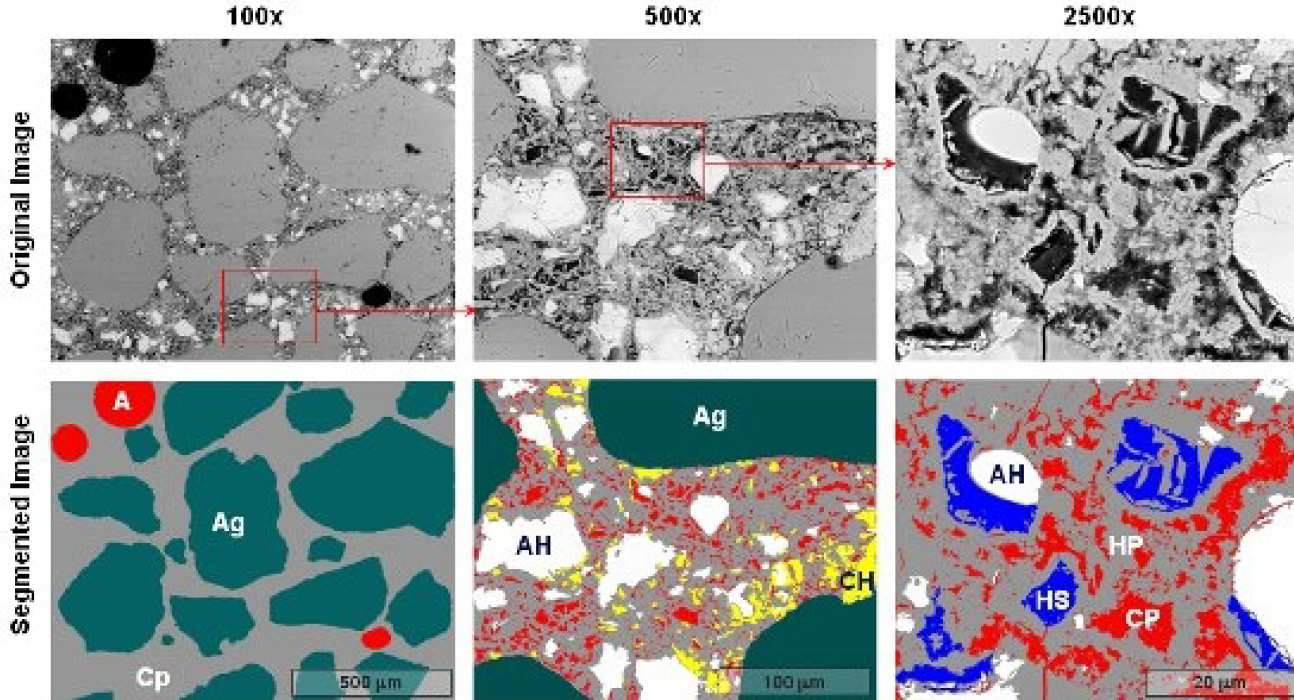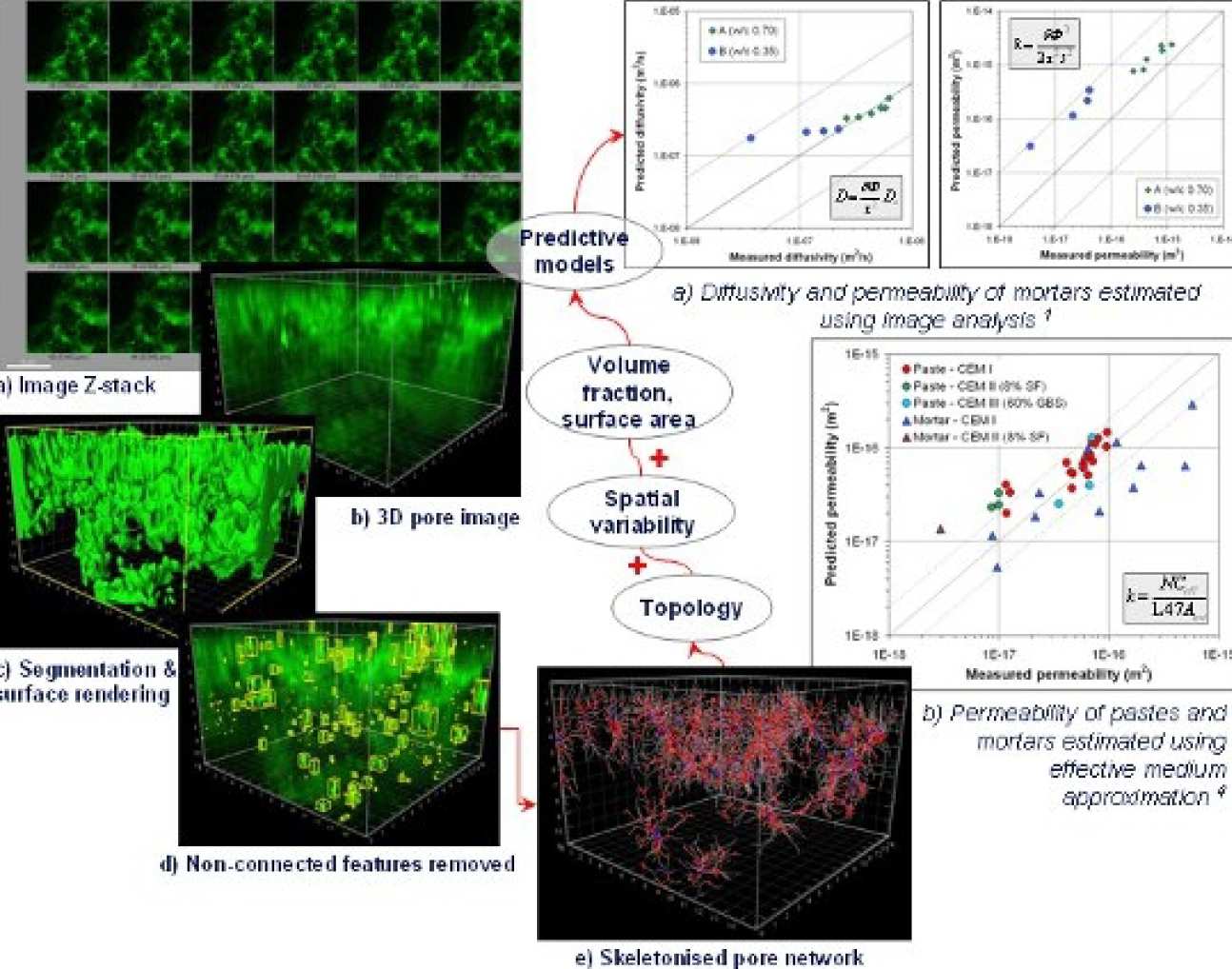All of the common deterioration processes affecting concrete structures are rate-controlled by ionic/molecular transport through the inevitably porous microstructure. This project aims to develop an improved understanding of the influence of pore structure on the transport properties of concrete.
Objectives:
- develop 2D and 3D image analysis to characterise microstructure;
- understand how pores, microcracks and other phases control transport;
- characterise the heterogeneity and spatial variability;
- reconstruct a global microstructural model for transport simulation;
- develop models to predict transport from quantified microstructure.
A multi-scale imaging approach combining optical microscopy, backscattered electron microscopy, and laser scanning confocal microscopy is used to characterise all phases important to transport at the right length scale giving global information (volume fraction, specific surface), morphology and topology (tortuosity, connectivity, constrictivity).
Transport properties are measured and correlated to the microstructure, to identify the influence and relative contribution of different types and sizes of pores, microcracks, ITZ and other phases. Information of the relevant phases, including their spatial variability, are used to reconstruct a multi-scale model from which transport processes are simulated. Models for predicting transport properties are developed from classical transport theories, and flow simulation using network modelling and effective medium approximation.
General approach

Samples are prepared with a range of microstructure characteristics by varying the water/cement ratio, binder type, maturity and aggregate volume fraction.
Transport properties

Samples are conditioned to constant weight, then tested following the sequence of oxygen diffusivity, oxygen permeability, sorptivity and resistivity.
Field-emission scanning electron microscopy and 3D confocal imaging
Samples are imaged at several magnification to characterise all phases relevant to transport. Air voids (A), aggregates (Ag), unreacted cement (AH), cement paste (CP), calcium hydroxide (CH), capillary pores (CP), hollow shell pores (HS) and other hydration products (HP) will be segmented and measured. The spatial distribution of the various phases are measured.

Three-dimensional pore structure imaged using Laser Scanning Confocal Microscopy. Pores are segmented, surface rendered and non-connected features removed. The remaining connected pore space is eroded to form a skeletonised pore network to determine topology. The extracted pore data from 2D and 3D microscopy will then be used as inputs to transport prediction models.

References:
- H.S. Wong, N.R. Buenfeld, M.K. Head (2006), Estimating transport properties of mortars using image analysis on backscattered electron images, Cem. Concr. Res., 36 [8] 1556-1566.
- M.K. Head, N.R. Buenfeld (2006), Confocal imaging of porosity in hardened concrete, Cem. Concr. Res., 36, 896-911
- M.K. Head, H.S. Wong, N.R. Buenfeld (2006), Characterising of ‘Hadley’ grain by confocal microscopy, Cem. Concr. Res., 36, 1483-1489
- H.S. Wong, R.W. Zimmerman, N.R. Buenfeld (2010), Estimating the permeability of cement-based materials using image analysis and effective medium theory, Symposium on Concrete Modelling, CONMOD 2010, 22-25 June, EPFL, Lausanne, 37-40
- H.S. Wong, R.W. Zimmerman, N.R. Buenfeld (2012), Estimating the permeability of cement-based materials using image analysis and effective medium theory, Cem. Concr. Res., 42, 476-483.
- S. Dehghanpoor Abyaneh, H.S. Wong, N.R. Buenfeld (2014), Computational investigation of capillary absorption in concrete using a three-dimensional mesoscale approach, Computational Materials Science, 87, 54-64.
- S. Dehghanpoor Abyaneh, H.S. Wong, N.R. Buenfeld (2013), Modelling the diffusivity of mortar and concrete using a three-dimensional mesostructure with several aggregate shapes, Computational Materials Science, 78, 63-73.
- S.Dehghanpoor-Abyaneh, H.S. Wong, N.R. Buenfeld (2013), Modelling the transport properties of concrete from three-dimensional mesostructure, TRANSCEND Conference, 3-6 November 2013, Guildford
- S. Dehghanpoor Abyaneh, H.S. Wong, N.R. Buenfeld (2012), Investigating into the diffusivity of concrete using a three dimensional multi-phase model, 3rd International Conference on the Durability of Concrete Structures, 17-19 Sept, Queen’s University Belfast
- S.D. Abyaneh, H.S. Wong and N.R. Buenfeld (2015), Modelling the effect of microcracks on the transport properties of concrete in three-dimensions, CONCREEP-10
Contact us
Prof Nick Buenfeld
Tel: +44 (0)20 7594 5955
E-Mail: n.buenfeld@imperial.ac.uk